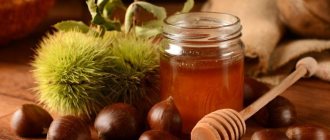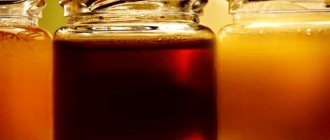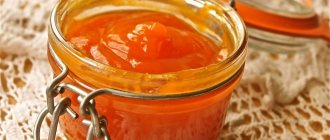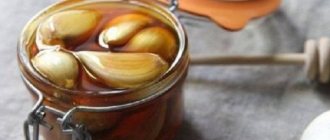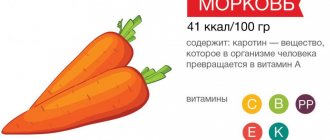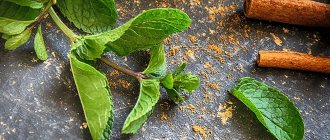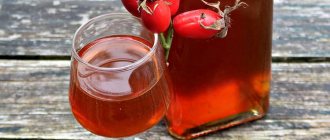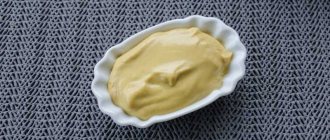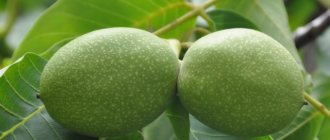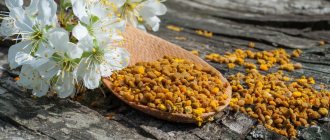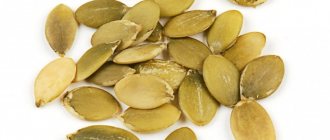In beekeeping products there are rare varieties that exhibit a large list of beneficial properties. Similar varieties include coriander honey. Nectar has an attractive taste and smell, which makes the product a pleasant dish. It has also spread in medicine. Coriander honey is used to improve immunity, eliminate disturbances in the functioning of the digestive system, and treat colds and viral diseases.
Description and differences
Coriander, a herbaceous plant known as a seasoning, acts as a honey plant for insects. In ordinary life, the name “cilantro” has taken root. This is the name given to the green part (leaves, stems) of the plant. Actually, coriander is a fruit.
Cilantro rarely grows over a large area, making it difficult for insects to collect nectar. Another obstacle is the rich, slightly off-putting scent of white or pink flowers, which does not attract bees. For targeted pollen collection, beekeepers move hives closer to the growing area.
The plant loves warm weather, so coriander fields are common in the Caucasus and the Crimean Peninsula. Flowering occurs from June to August.
Distinctive physical properties:
- color – characteristic, light brown or dark amber with a golden tint;
- the smell is specific, with spicy notes, due to the presence of essential oils;
- taste – sweet, caramel, with an unobtrusive medicinal aftertaste;
- sugaring – fast, 1–2 months after pumping out, large grains (crystals) appear;
- consistency – freshly collected nectar is liquid, slightly viscous, dense after crystallization.
Coriander is a spicy plant, so honey acquires specific physical properties. Honey plant transmits oily esters, iron, manganese, copper, which give a characteristic color, taste, and smell.
Field crops honey plants
Cultivated (agricultural) honey plants are cultivated in almost all agricultural regions of the post-Soviet countries.
In many steppe and forest-steppe regions, these melliferous crops serve as the main source of honey.
But the greatest interest for beekeeping as an industry is the honey plant: buckwheat, mustard, sunflower, coriander, phacelia, sainfoin, pink and white clover, sweet clover and other crops.
buckwheat honey plant is a valuable honey plant, from which in a favorable year you can get up to 100 kg of high-quality honey from one hectare. The greatest activity of bees visiting buckwheat during its flowering is observed in the first half of the day and in the evening. Honey collected from buckwheat has a sharp, pleasant aroma and a pungent taste.
sunflower honey plant is also a valuable honey plant. Although sunflower produces slightly less nectar than buckwheat, the presence of huge areas under crops of this crop is equated to the category of the best honey plants. Mass flowering of sunflower occurs in July - August, flowering duration is about a month (3-4 weeks). Sunflower honey can be considered one of the best existing varieties of honey; it has a light yellow tint, a barely perceptible pleasant aroma and a delicate taste.
mustard plant (Sarepta, white) is an annual oilseed plant, which is also of considerable value for beekeepers. This is due to a fairly long flowering period, which begins approximately on the fortieth day from the time of sowing and lasts about 20 days. This honey plant is actively visited by bees mainly in the morning. Resorting to the statistics of honey production, it can be noted that from 1 hectare of Sarepta mustard you can get up to 60 kg of honey, from a hectare of white mustard - from 50 to 100 kilograms. Mustard honey is light yellow in color, has a pleasant aroma and a unique taste.
The honey plant rapeseed is also an annual oilseed plant. There is spring and winter rape.
Choosing the sweetest varieties of apple trees
So the second one gives the bees an early honey harvest, which, of course, is important for the spring development of bee colonies.
Winter rapeseed blooms between the end of May and the beginning of June, at which time natural honey plants still practically do not bloom in nature.
The flowering period of rapeseed is 30 days, honey productivity varies from 30 to 60 kg per hectare.
Spring rape begins to bloom at the end of June and its flowering continues for about forty days. Honey productivity per 1 ha of spring rape reaches 80-100 kg per 1 ha.
coriander honey plant is an annual essential oil plant. Coriander is sown both in spring and for winter. Therefore, depending on the timing of sowing, it blooms in different periods: spring sowing blooms in late June - early July, while winter sowing begins to bloom approximately a couple of weeks earlier. The flowering period of this honey plant is one month, honey productivity varies from 60 to 120 kg, in some cases, if there are favorable conditions, up to two hundred kg of honey per hectare can be obtained from 1 hectare of coriander. Coriander honey has a unique taste and pungent aroma.
clover honey plant is a valuable perennial forage crop from the legume family. There are the following types of clover: single-cut (late-ripening) and double-cut (early-ripening). Using statistics, it can be noted that from one hectare of single-cut red clover, bees of the Central Russian breed collect up to 10 kilograms of honey, while from double-cut clover - up to 25 kilograms.
sainfoin honey plant is a perennial plant of the legume family, which is an excellent forage crop. Sowing sainfoin helps increase soil fertility and improve its structure. Sainfoin begins to bloom in late May - early June, the flowering period is from 15 to 20 days. Honey productivity from 1 hectare of crops reaches 120 kg of honey with pleasant taste. For a beekeeper, sainfoin is of great value because its flowering usually occurs at a time when there are relatively few flowering honey plants in nature.
clover plant (biennial white clover and biennial yellow clover) is a good forage plant and an excellent honey plant.
It is of greatest value for livestock breeding; it is used for silage, as hay, as pasture feed, and is also used as green manure.
Sweet clover blooms for a very long time: from July to late autumn.
Honey productivity is expressed in 100-200 kg of honey. For beekeeping, it is more advisable to use annual white sweet clover; when sowing, it can be used as a special honey plant with subsequent processing into green fertilizer or silage. Sweet clover honey has high taste qualities and a very delicate and pleasant aroma.
alfalfa honey plant is a perennial plant of the legume family. A good honey plant is blue or seed alfalfa. Honey productivity when irrigating this crop reaches “fabulous” results: up to 300 kg of honey per 1 ha! The honey productivity of alfalfa without irrigation is 25-50 kg per hectare. Alfalfa blooms in June - July. Alfalfa honey extracted from honeycombs has an amber-golden appearance and crystallizes fairly quickly.
Rhododendron: status obliges. Choosing a landing site and suitable environment
Fava beans are excellent annual honey plants that bloom in June - July. The plant provides bees with a lot of nectar. However, the nectar-bearing capacity of faba beans directly depends on the weather: the most favorable weather for the flower to produce maximum nectar is warm and somewhat humid. Honey productivity ranges from several kilograms to 46 kg per hectare.
Echinacea purpurea is a perennial herbaceous plant. The duration of flowering of Echinacea in the second year of life is 2-2.5 months. Honey productivity - up to 130 kg of honey from 1 hectare of continuous grass stand. This crop is especially valuable because it begins to bloom at the end of summer, when other honey plants have almost faded and the bees feel a lack of food. Echinacea purpurea is cultivated as a medicinal plant in special farms.
Composition and calorie content
The rare occurrence of the variety does not prevent the bee product from being saturated with useful elements from the honey plant. The plant gives the composition a uniqueness, which makes coriander flower nectar stand out from other beekeeping products. Components:
- carbohydrates (glucose, fructose, sugars, polysaccharides) – 80–82%;
- moisture – 16–18%;
- protein substances – 0.8–1%;
- vitamins – ascorbic acid, group B, niacin, biotin;
- trace elements, minerals – copper, iron, manganese, potassium, phosphorus, zinc;
- amino acid series, enzymes;
- oily esters – 10 varieties;
- organic acids – malic, lactic, citric;
- fats are not detected.
The calorie content of cilantro flower nectar is 306–310 kcal, which is considered “below average” among beekeeping product varieties. Convenient calculation: teaspoon – 31–35 kcal, large spoon – 100–104 kcal. A faceted glass contains 615–619 kcal.
Coriander honey - beneficial properties
The balance of glucose and fructose, the presence of essential oils, trace elements and vitamins are the factors that determined the healing properties of cilantro flower nectar. Coriander honey exhibits the following beneficial properties:
- strengthening the body's protective barriers;
- fight against colds, viral and respiratory diseases;
- destructive effect on pathogenic microorganisms;
- pain relief, relief of symptoms of inflammatory reaction;
- saturating the body with antioxidants, vitamins, microelements;
- stabilization of digestive processes;
- activation of gastric juice secretion;
- decreased sugar levels and increased hemoglobin in the blood;
- healing of damage to the skin and mucous membranes;
- fight against insomnia, stress, nervous disorders;
- improvement of visual abilities, restoration of vision;
- cleansing blood vessels from “bad” cholesterol.
Bee product is beneficial for men. It helps with decreased libido and impotence. To restore erection, a honey-based balm with the addition of aloe juice and red wine is recommended. The drink will increase blood flow to the genitals.
The benefits of infusion of flower nectar and beet juice for eliminating hemorrhoids have been noted. The product is applied to external hemorrhoids. Within a week the discomfort disappears.
The beneficial properties of cilantro honey are used in cosmetology. The product eliminates acne, pimples and wrinkles, restores skin tone and elasticity, and slows down aging. The main method of use is honey masks. To enhance the effect, other ingredients are added, such as sage.
Coriander honey is distinguished by its ability to preserve beneficial substances for a long time. However, to prevent loss of usefulness, it is recommended to observe the following storage conditions:
- dense, airtight container;
- dry, dark, cool place, temperature - up to 18 degrees;
- storage away from other products.
The healing properties of cilantro flower nectar have been known for a long time. The components included in the bee product provide benefits. Honey gets these substances from the plant. Healing qualities help strengthen the body, remove symptoms of inflammation and infectious diseases.
Where can I get pure coriander honey?
If you do not live in the southern regions, this is difficult. You need to take care of finding a real supplier of a quality product from the south, set up logistics, reminding the manufacturer every year with a call - coriander honey literally flies away, despite its high price. There are a number of companies selling honey - you can look for a supplier among them.
This is interesting Clover honey and its healing properties
In the southern regions it is easier: you need a decent beekeeper who is familiar with collecting this type of honey. We advise you not to discuss the price - honey with this name will sell out even without your participation. The demand for it is generated by experts in traditional medicine, athletes, doctors, people of various professions related to physical activity and working in shifts.
How to distinguish coriander honey from fake
Beekeeping products are often counterfeited. Coriander honey is no exception. It is considered rare, so cheap varieties are often passed off as real nectar. Signs of a natural product:
- Coriander nectar is obtained in regions with warm climates, so it is advisable to find out where the product came from. The main areas where honey is collected are Crimea, Transcaucasia, and Central Asia.
- Physical properties. The natural product quickly becomes sugary. If there is a liquid product on the shelves in winter, then it is a fake. The color is light brown or dark amber, the smell is reminiscent of coriander.
The only way to protect yourself from buying a fake product is to find a beekeeper with quality products. If this is not possible, then it is better to focus on the listed signs.
Contraindications
Restrictions on the use of coriander bee product:
- allergic reaction to components;
- low pressure;
- skin diseases;
- pregnancy, period of feeding a child;
- excess weight.
Coriander honey is rare. In terms of healing properties, it surpasses most common varieties. The main advantage is the presence of essential oils, iron, manganese, copper, and vitamins. These substances help cope with various diseases and disorders.
For whom is coriander honey contraindicated?
Before using this “gift of nature” in treatment, it is worth checking how the body perceives its components. In some cases, this manifests itself as an allergic reaction, and sometimes as an individual intolerance. At the same time, there are specific contraindications to the use of coriander honey:
- diabetes;
- pregnancy or breastfeeding;
- age restrictions – up to 2 years;
- hypotension;
- late stages of obesity;
- allergy.
Experts have determined the daily intake of honey. The maximum dose for adults is 100 g, and for children (up to 7 years) – 30 g.
It is important to always “listen” to your body. Sometimes a person may not be aware of a particular problem. Therefore, it is necessary to gradually introduce coriander honey into your family’s menu. The first symptoms of the problem may be:
- discomfort in the intestines or stomach;
- shortness of breath or difficulty breathing;
- A rash/hives appears on the body.
Sainfoin and its benefits as a honey plant
In such cases, beekeeping products are removed from the diet. If necessary, the stomach and intestines are washed. Then they turn to a specialist.
It is eaten especially carefully when being treated with medications. Very often, strong drugs are incompatible with the components of honey, because it is a natural antibiotic. In this case, it is better to consult a doctor.
